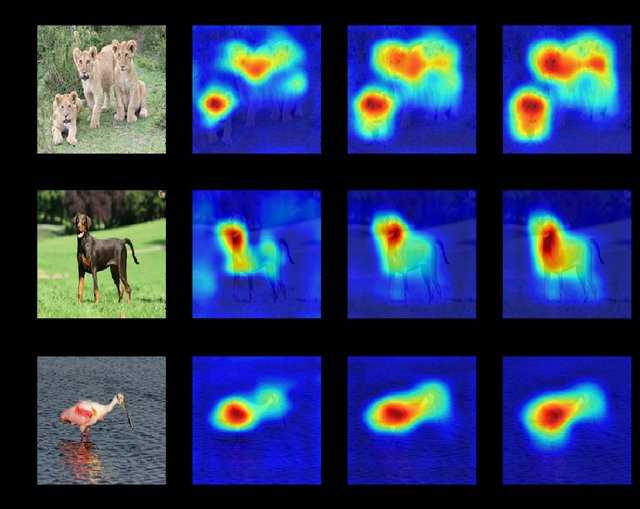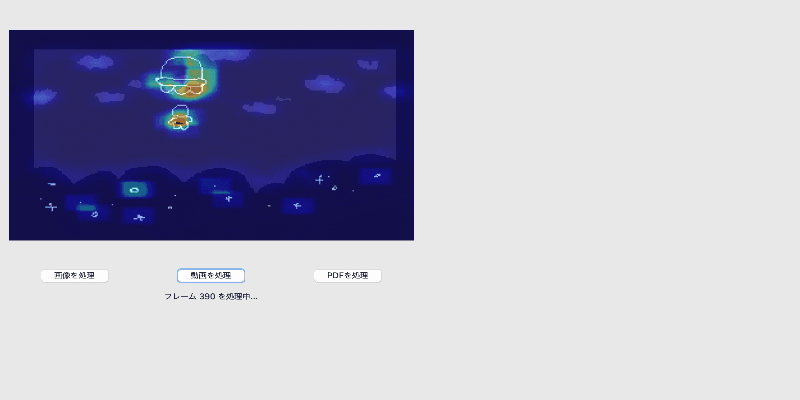はじめに
Saliencyとは
- サリエンシー(Saliency) =「顕著性」「目立ちやすさ」
- 画像や映像において、人間の注意を引きつけやすい特徴や領域を指す
サリエンシーマップとは
- 画像や映像の中で、各領域がどの程度目立つかを視覚的に表現したもの
- 人間の視覚的注意を予測するモデルとして使用される
サリエンシーマップの主な用途
- マーケティング:広告の効果を予測・分析
- UI設計:重要な要素が目立つようにデザインを調整
- コンピュータビジョン:物体検出や画像分割のための前処理として使用
本題
やりたいこと
- 意図した情報やメッセージを効果的に伝えるための分析を簡単に行いたい
- サリエンシーマップを使うことで、自然に目が引きつけられる領域を特定し、それに基づいて効果的な視線誘導ができているかを確認したい
つくってみる
- 画像、動画、PDFをインプットに処理できるようにした
- 処理結果として、サリエンシーマップを重ねた画像、動画がzipファイルでDLできるようにする
- tkinterを使ってGUIで動かせるようにしてみた
動作イメージ
実行コード
# 必要なライブラリのインストール
pip install opencv-python-headless # OpenCV
pip install numpy # NumPy
pip install pillow # Pillow
pip install pdf2image # PDF to image変換
pip install imageio # ImageIO
brew install poppler
Saliency_Map_GUI.py
import tkinter as tk
from tkinter import ttk, filedialog, messagebox
import cv2
import numpy as np
from PIL import Image, ImageTk
import os
import zipfile
from pdf2image import convert_from_path
import imageio
import tempfile
from datetime import datetime
class SaliencyApp:
def __init__(self, root):
self.root = root
self.root.title("Saliency Map Generator")
# メインフレーム
self.main_frame = ttk.Frame(root, padding="10")
self.main_frame.grid(row=0, column=0, sticky=(tk.W, tk.E, tk.N, tk.S))
# プレビューキャンバス
self.canvas = tk.Canvas(self.main_frame, width=600, height=400)
self.canvas.grid(row=0, column=0, columnspan=3, pady=5)
# ボタン
ttk.Button(self.main_frame, text="画像を処理", command=self.process_image).grid(row=1, column=0, pady=5, padx=5)
ttk.Button(self.main_frame, text="動画を処理", command=self.process_video).grid(row=1, column=1, pady=5, padx=5)
ttk.Button(self.main_frame, text="PDFを処理", command=self.process_pdf).grid(row=1, column=2, pady=5, padx=5)
# ステータスバー
self.status_var = tk.StringVar()
self.status_var.set("準備完了")
ttk.Label(self.main_frame, textvariable=self.status_var).grid(row=2, column=0, columnspan=3, pady=5)
# 一時ファイル用のディレクトリを作成
self.temp_dir = tempfile.mkdtemp()
def __del__(self):
# 終了時に一時ディレクトリを削除
try:
import shutil
shutil.rmtree(self.temp_dir)
except:
pass
def __saliency(self, src):
saliency = cv2.saliency.StaticSaliencySpectralResidual_create()
(success, saliency_map) = saliency.computeSaliency(src)
if not success:
return (False, None)
saliency_map = (saliency_map * 255).astype("uint8")
heatmap = cv2.applyColorMap(saliency_map, cv2.COLORMAP_JET)
weight = cv2.addWeighted(src, 0.7, heatmap, 0.5, 1.0)
return (True, weight)
def update_preview(self, cv_image):
# OpenCV画像をPIL形式に変換
image = cv2.cvtColor(cv_image, cv2.COLOR_BGR2RGB)
image = Image.fromarray(image)
# キャンバスのサイズに合わせてリサイズ
canvas_width = self.canvas.winfo_width()
canvas_height = self.canvas.winfo_height()
image.thumbnail((canvas_width, canvas_height), Image.Resampling.LANCZOS)
# PhotoImageに変換してキャンバスに表示
photo = ImageTk.PhotoImage(image)
self.canvas.create_image(canvas_width//2, canvas_height//2, image=photo, anchor="center")
self.canvas.image = photo
def create_zip(self, files, zip_name):
timestamp = datetime.now().strftime("%Y%m%d_%H%M%S")
zip_path = filedialog.asksaveasfilename(
defaultextension=".zip",
initialfile=f"{zip_name}_{timestamp}.zip",
filetypes=[("ZIP files", "*.zip")]
)
if not zip_path:
return None
with zipfile.ZipFile(zip_path, 'w') as zipf:
for file in files:
if os.path.exists(file):
zipf.write(file, os.path.basename(file))
os.remove(file) # 一時ファイルを削除
return zip_path
def process_image(self):
file_paths = filedialog.askopenfilenames(
filetypes=[("Image files", "*.jpg *.jpeg *.png *.bmp *.gif")]
)
if not file_paths:
return
processed_files = []
for file_path in file_paths:
self.status_var.set(f"画像を処理中... {os.path.basename(file_path)}")
self.root.update()
try:
# 画像を読み込み
image = cv2.imread(file_path)
if image is None:
raise ValueError(f"画像の読み込みに失敗しました: {file_path}")
# サリエンシーマップを適用
success, result = self.__saliency(image)
if not success:
raise ValueError(f"サリエンシーマップの生成に失敗しました: {file_path}")
# プレビューを更新
self.update_preview(result)
# 一時ファイルとして保存
temp_file = os.path.join(self.temp_dir, f"saliency_{os.path.basename(file_path)}")
cv2.imwrite(temp_file, result)
processed_files.append(temp_file)
except Exception as e:
messagebox.showwarning("警告", str(e))
if processed_files:
zip_path = self.create_zip(processed_files, "image_results")
if zip_path:
self.status_var.set(f"保存完了: {os.path.basename(zip_path)}")
else:
self.status_var.set("保存がキャンセルされました")
else:
self.status_var.set("処理可能な画像がありませんでした")
self.root.update()
def process_video(self):
file_path = filedialog.askopenfilename(
filetypes=[("Video files", "*.mp4 *.avi *.mov")]
)
if not file_path:
return
self.status_var.set("動画を処理中...")
self.root.update()
try:
# 動画を読み込み
video = cv2.VideoCapture(file_path)
if not video.isOpened():
raise ValueError("動画の読み込みに失敗しました")
# 一時ファイルとして保存
temp_file = os.path.join(self.temp_dir, f"saliency_{os.path.basename(file_path)}")
# 出力用のビデオライターを準備
fourcc = cv2.VideoWriter_fourcc(*'mp4v')
fps = video.get(cv2.CAP_PROP_FPS)
width = int(video.get(cv2.CAP_PROP_FRAME_WIDTH))
height = int(video.get(cv2.CAP_PROP_FRAME_HEIGHT))
writer = cv2.VideoWriter(temp_file, fourcc, fps, (width, height))
frame_count = 0
while True:
ret, frame = video.read()
if not ret:
break
# サリエンシーマップを適用
success, result = self.__saliency(frame)
if success:
writer.write(result)
if frame_count % 30 == 0: # 30フレームごとにプレビューを更新
self.update_preview(result)
self.status_var.set(f"フレーム {frame_count} を処理中...")
self.root.update()
frame_count += 1
video.release()
writer.release()
# ZIPファイルとして保存
zip_path = self.create_zip([temp_file], "video_results")
if zip_path:
self.status_var.set(f"保存完了: {os.path.basename(zip_path)}")
else:
self.status_var.set("保存がキャンセルされました")
except Exception as e:
messagebox.showerror("エラー", str(e))
self.status_var.set("エラーが発生しました")
self.root.update()
def process_pdf(self):
file_path = filedialog.askopenfilename(
filetypes=[("PDF files", "*.pdf")]
)
if not file_path:
return
self.status_var.set("PDFを処理中...")
self.root.update()
try:
# PDFを画像に変換
pages = convert_from_path(file_path)
processed_files = []
for i, page in enumerate(pages):
# PIL ImageをOpenCV形式に変換
page_cv = cv2.cvtColor(np.array(page), cv2.COLOR_RGB2BGR)
# サリエンシーマップを適用
success, result = self.__saliency(page_cv)
if success:
# プレビューを更新
self.update_preview(result)
self.status_var.set(f"ページ {i+1}/{len(pages)} を処理中...")
self.root.update()
# 一時ファイルとして保存
temp_file = os.path.join(self.temp_dir, f"saliency_page_{i+1}.jpg")
cv2.imwrite(temp_file, result)
processed_files.append(temp_file)
if processed_files:
zip_path = self.create_zip(processed_files, "pdf_results")
if zip_path:
self.status_var.set(f"保存完了: {os.path.basename(zip_path)}")
else:
self.status_var.set("保存がキャンセルされました")
else:
self.status_var.set("処理可能なページがありませんでした")
except Exception as e:
messagebox.showerror("エラー", str(e))
self.status_var.set("エラーが発生しました")
self.root.update()
def main():
root = tk.Tk()
app = SaliencyApp(root)
root.mainloop()
if __name__ == "__main__":
main()


